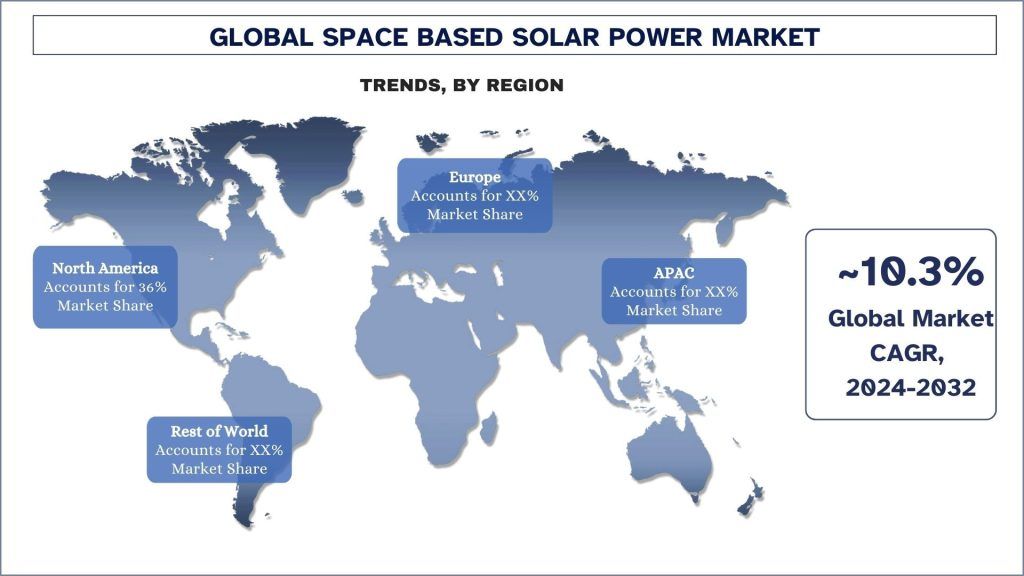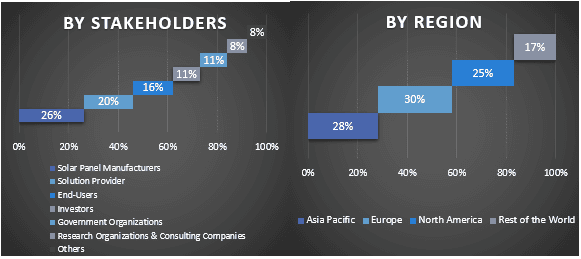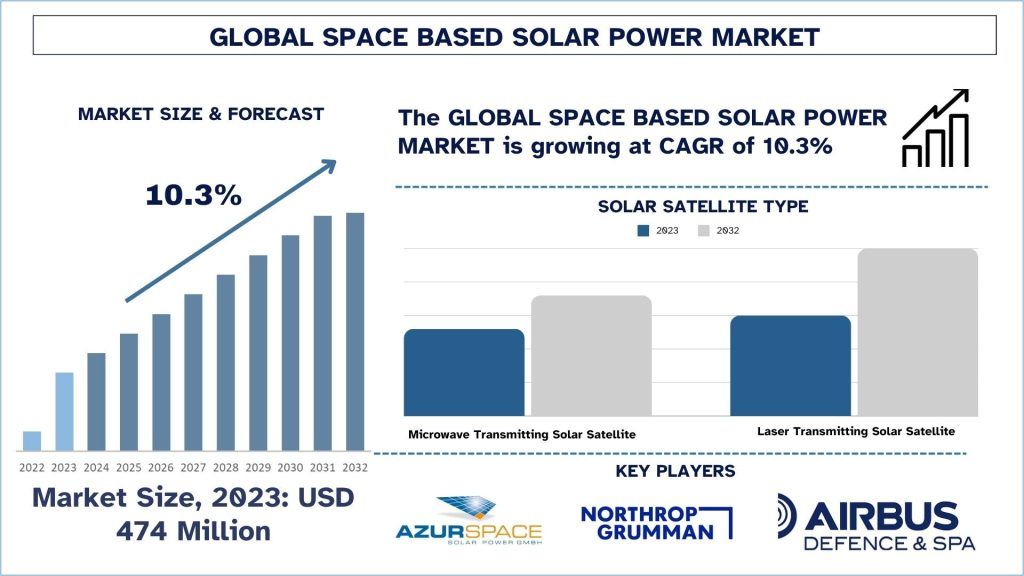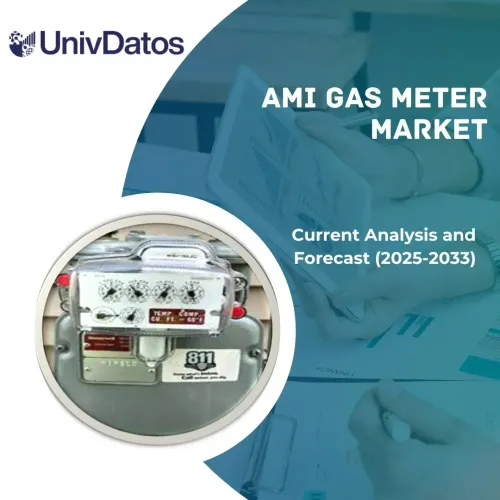- Home
- About Us
- Industry
- Services
- Reading
- Contact Us
Space-Based Solar Power Market: Current Analysis and Forecast (2024-2032)
Emphasis on Solar Satellite Type (Microwave-Transmitting Solar Satellites, and Laser-Transmitting Solar Satellites); Application (Electricity Generation and Space Applications); and Region/Country
Space-Based Solar Power Market Size & Forecast
The Space-Based Solar Power Market was valued at USD 474 million in 2023 and is expected to grow at a strong CAGR of around 10.3% during the forecast period (2024-2032). Space-based solar panels involve collecting the sun’s energy in space and then wirelessly transmitting it to Earth. The space-based solar panel technological process includes using solar panels to collect solar energy in space with reflectors or inflatable mirrors that direct solar radiation onto solar panels and then beam it onto Earth through a microwave or laser. A few key players in the space-based solar panel are taking various initiatives to harness the energy in space. For instance: In 2021, China revealed the plan to launch a fleet of mile-long solar panels into space to beam energy back to Earth by 2035. Space-based solar power has several benefits unlike solar panels on our roofs that can only generate electricity during the day, space-based solar power can generate continuous electricity, 24 hours a day, 99% of the year which is further accelerating the demand for Space-Based Solar Power Market.
Space-Based Solar Power Market Analysis
The global space-based solar power (SBSP) market is emerging as a groundbreaking technology for sustainable energy solutions. SBSP involves collecting solar energy in space, where sunlight is abundant and uninterrupted, and transmitting it to Earth. The space-based solar power is an innovative approach that has the potential to provide a continuous, clean, and limitless energy supply, overcoming many limitations of terrestrial solar power systems which will further escalate the market size of the Space-Based Solar Power Market.

Space-Based Solar Power Market Trends
Technological Advancements in Wireless Power Transmission
Efficiently transmitting solar energy collected in space to Earth is crucial for the viability of SBSP systems. This trend encompasses innovations in both microwave and laser-based power transmission methods, aiming to maximize energy transfer efficiency while minimizing losses. For instance: In December 2022, JAXA successfully conducted a microwave power transmission test, marking a significant milestone in SBSP technology. During this test, the agency transmitted 1.8 kilowatts of power over 55 meters using microwave beams. This experiment demonstrated the feasibility of converting solar energy into microwave energy and transmitting it with high efficiency to a designated receiver.

North America is Expected to Grow with Significant CAGR During Forecast Period
The quest for sustainable and continuous energy sources has driven innovation and exploration beyond our terrestrial confines. Among the pioneering advancements in this arena is Space-Based Solar Power (SBSP). This revolutionary concept has garnered significant attention and investment, particularly in North America, as nations and corporations seek to address the escalating demand for clean energy. SBSP promises to harness the sun’s inexhaustible energy directly from space, offering a myriad of benefits over traditional ground-based solar power systems. As North America sets its sights on this futuristic energy solution, the implications for the global energy market are profound and transformative.
Space-based Solar Power Industry Overview
The Space-Based Solar Power Market is competitive and fragmented, with the presence of several global and international market players. The key players are adopting different growth strategies to enhance their market presence, such as partnerships, agreements, collaborations, new product launches, geographical expansions, and mergers and acquisitions. Some of the major players operating in the market are AZUR SPACE Solar Power, Northrop Grumman, Airbus Defence and Space, China Academy of Space Technology, Borrego, Blue Origin, Airbus, Solaren Corporation, Caltech, and the European Space Agency.
Space-based Solar Power Market News
- In 2021, China revealed the plan to launch a fleet of mile-long solar panels into space to beam energy back to Earth by 2035.
- In 2022, JAXA successfully tested a microwave power transmission system, demonstrating the viability of wireless energy transfer from space to Earth.
Space-Based Solar Power Market Report Coverage

Reasons to buy this report:
- The study includes market sizing and forecasting analysis validated by authenticated key industry experts.
- The report presents a quick review of overall industry performance at one glance.
- The report covers an in-depth analysis of prominent industry peers with a primary focus on key business financials, product portfolios, expansion strategies, and recent developments.
- Detailed examination of drivers, restraints, key trends, and opportunities prevailing in the industry.
- The study comprehensively covers the market across different segments.
- Deep dive regional level analysis of the industry.
Customization Options:
The Global Space-Based Solar Power Market can further be customized as per the requirement or any other market segment. Besides this, UMI understands that you may have your own business needs, hence feel free to connect with us to get a report that completely suits your requirements.
Table of Content
Research Methodology for the Space-Based Solar Power Market Analysis (2024-2032)
Analyzing the historical market, estimating the current market, and forecasting the future market of the Global Space-Based Solar Power Market were the three major steps undertaken to create and analyze the adoption of Space-based solar power in major regions globally. Exhaustive secondary research was conducted to collect the historical market numbers and estimate the current market size. Secondly, to validate these insights, numerous findings and assumptions were taken into consideration. Moreover, exhaustive primary interviews were also conducted, with industry experts across the value chain of the Global Space-Based Solar Power Market. Post assumption and validation of market numbers through primary interviews, we employed a top-down/bottom-up approach to forecasting the complete market size. Thereafter, market breakdown and data triangulation methods were adopted to estimate and analyze the market size of segments and sub-segments of the industry pertains to. Detailed methodology is explained below:
Analysis of Historical Market Size
Step 1: In-Depth Study of Secondary Sources:
A detailed secondary study was conducted to obtain the historical market size of the Space-Based Solar Power Market through company internal sources such as annual reports & financial statements, performance presentations, press releases, etc., and external sources including journals, news & articles, government publications, competitor publications, sector reports, third-party database, and other credible publications.
Step 2: Market Segmentation:
After obtaining the historical market size of the Space-Based Solar Power Market, we conducted a detailed secondary analysis to gather historical market insights and share for different segments & sub-segments for major regions. Major segments are included in the report as solar satellite type and application. Further country-level analyses were conducted to evaluate the overall adoption of testing models in that region.
Step 3: Factor Analysis:
After acquiring the historical market size of different segments and sub-segments, we conducted a detailed factor analysis to estimate the current market size of the Space-Based Solar Power Market. Further, we conducted factor analysis using dependent and independent variables such as solar satellite type and application of the Space-Based Solar Power Market. A thorough analysis was conducted of demand and supply-side scenarios considering top partnerships, mergers and acquisitions, business expansion, and product launches in the Space-Based Solar Power Market sector across the globe.
Current Market Size Estimate & Forecast
Current Market Sizing: Based on actionable insights from the above 3 steps, we arrived at the current market size, key players in the Global Space-Based Solar Power Market, and market shares of the segments. All the required percentage shares split, and market breakdowns were determined using the above-mentioned secondary approach and were verified through primary interviews.
Estimation & Forecasting: For market estimation and forecast, weights were assigned to varied factors including drivers & trends, restraints, and opportunities available for the stakeholders. After analyzing these factors, relevant forecasting techniques i.e., the top-down/bottom-up approach were applied to arrive at the market forecast for 2032 for different segments and sub-segments across the major markets globally. The research methodology adopted to estimate the market size encompasses:
- The industry’s market size, in terms of revenue (USD) and the adoption rate of the Space based solar power market across the major markets domestically
- All percentage shares, splits, and breakdowns of market segments and sub-segments
- Key players in the global Space based solar power market in terms of products offered. Also, the growth strategies adopted by these players to compete in the fast-growing market
Market Size and Share Validation
Primary Research: In-depth interviews were conducted with the Key Opinion Leaders (KOLs) including Top Level Executives (CXO/VPs, Sales Head, Marketing Head, Operational Head, Regional Head, Country Head, etc.) across major regions. Primary research findings were then summarized, and statistical analysis was performed to prove the stated hypothesis. Inputs from primary research were consolidated with secondary findings, hence turning information into actionable insights.
Split of Primary Participants in Different Regions

Market Engineering
The data triangulation technique was employed to complete the overall market estimation and to arrive at precise statistical numbers for each segment and sub-segment of the Global Space-Based Solar Power Market. Data was split into several segments & sub-segments post studying various parameters and trends in the areas of the solar satellite type and application in the Global Space-Based Solar Power Market.
The main objective of the Global Space-Based Solar Power Market Study
The current & future market trends of the Global Space-Based Solar Power Market were pinpointed in the study. Investors can gain strategic insights to base their discretion for investments on the qualitative and quantitative analysis performed in the study. Current and future market trends determined the overall attractiveness of the market at a regional level, providing a platform for the industrial participant to exploit the untapped market to benefit from a first-mover advantage. Other quantitative goals of the studies include:
- Analyze the current and forecast market size of the Space-Based Solar Power Market in terms of value (USD). Also, analyze the current and forecast market size of different segments and sub-segments.
- Segments in the study include areas of the solar satellite type and application.
- Define and analysis of the regulatory framework for the space-based solar power
- Analyze the value chain involved with the presence of various intermediaries, along with analyzing customer and competitor behaviors of the industry.
- Analyze the current and forecast market size of the Space-Based Solar Power Market for the major region.
- Major countries of regions studied in the report include Asia Pacific, Europe, North America, and the Rest of the World
- Company profiles of the Space-Based Solar Power Market and the growth strategies adopted by the market players to sustain in the fast-growing market.
- Deep dive regional level analysis of the industry.
Frequently Asked Questions FAQs
Q1: What is the current market size and growth potential of the Space based solar power market?
Q2: What are the driving factors for the growth of the Space-based solar power market?
Q3: Which segment has the largest share of the Space-based solar power market by Solar Satellite Type?
Q4: What are the emerging technologies and trends in the Space-based solar power market?
Q5: Which region will dominate the Space-based solar power market?
Related Reports
Customers who bought this item also bought











